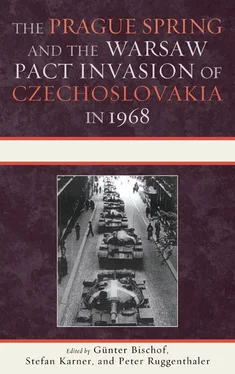Decisive as the military results may have been, they seemed rather hollow when the invasion failed to achieve its immediate political aims. 42The Soviet Union’s chief political objective on 20/21 August was to facilitate a rapid transition to a pro-Moscow “revolutionary government,” as had been done in Hungary in November 1956 when Soviet troops installed a “workers’ and peasants’ government” under Janoš Kádár. In Czechoslovakia, however, a pro-Moscow government failed to materialize immediately after the invasion. The “healthy forces” in Czechoslovakia were unable to gain majority support on the KSČ Presidium. The resulting confusion was well described in an emergency cable to Moscow from Kirill Mazurov, a Soviet Politburo member who had been sent to Czechoslovakia to oversee the political side of the invasion. Mazurov reported that the KSČ hardliners had “gone a bit haywire” and had “lost their nerve when Soviet military units were slightly late in arriving” at the KSČ Central Committee headquarters. 43Upon learning that troops had crossed into Czechoslovakia, the KSČ Presidium had voted seven to four to adopt a statement condemning the invasion, and this statement was broadcast repeatedly on radio and television over the next several hours and was published in full on the front page of a special edition of the main KSČ newspaper, Rudé právo , on 21 August. 44These developments, according to Mazurov, caused even greater disarray and panic among the “healthy forces,” who were “unable to recover from the shock.” 45
Despite this setback, Soviet leaders were reluctant to abandon their initial plan, apparently because they had neglected to devise any fallback options. It is surprising, even in retrospect, that they would have committed themselves so heavily to such a dubious strategy without having devised a viable alternative. No doubt, this was partly the fault of Soviet embassy officials in Prague and Soviet KGB sources who had assured the CPSU Politburo that the “healthy forces on the KSČ Presidium have finally consolidated themselves and closed their ranks so that they are now a majority.” 46The members of the CPSU Politburo genuinely expected that the invasion would earn widespread official and popular support (or at least acquiescence) once the “right-wing opportunists” in the KSČ were removed and the initial shock of the invasion wore off. Although martial law was to be imposed in certain parts of Czechoslovakia on 21 August, it was intended as a temporary and selective measure that could be lifted as soon as a “revolutionary government” was in place and the “antisocialist” and “counterrevolutionary” forces had been neutralized. 47The lack of any attempt by the invading troops to take over the functions of the Czechoslovak government or parliament, the very limited scale of the initial Soviet propaganda effort inside Czechoslovakia, and the meager quantity of provisions brought in by the Soviet and East European forces (because they assumed that they would be promptly resupplied by a friendly Czechoslovak government) all confirm that Soviet leaders were expecting a swift transition to a proMoscow regime. 48
Only after repeated efforts to set up a post-invasion government had collapsed and the invasion had met with overwhelming opposition in Czechoslovakia—both publicly and officially—did Soviet leaders get an inkling of how unfavorable the conditions in Czechoslovakia were. 49An internal Soviet Politburo report shortly after the invasion conceded that “75 to 90 percent of the [Czechoslovak] population… regard the entry of Soviet troops as an act of occupation.” 50Reports from Soviet diplomats indicated that even most KSČ members viewed the invasion in “highly negative” terms. 51Brezhnev and his colleagues acknowledged this point but were loath to admit that they had fundamentally misjudged the situation and had failed to take adequate precautions. Instead, they ascribed the fiasco solely to the “cowardly behavior” of the “healthy forces” in Czechoslovakia and the “lack of active propaganda work” by Soviet units. 52
Faced with massive popular and official resistance in Czechoslovakia, the Soviet Politburo decided to open negotiations on 23 August with Dubček and other KSČ officials who had been arrested on the morning of the 21st. After four days of talks, the two sides agreed to sign the Moscow Protocol, which forced the reversal of several elements of the Prague Spring but also ensured the reinstatement of most of the leading reformers, including Dubček. The decision to bring back key Czechoslovak officials did not go over well with some Soviet Politburo members and with hard-line leaders in Eastern Europe. At a Warsaw Pact conclave on 24 August, Gomułka insisted that Soviet and East European troops should be “ordered to combat the counterrevolution” and take “whatever steps are necessary” to “prevent rightists and counterrevolutionaries from regaining power.” 53In his view, “the situation in Hungary [in 1956] was better than in Czechoslovakia today.” Gomułka’s complaints were echoed by Ulbricht, who declared that “if Dubček and Černík are going to be back in the leadership, what was the point of sending our troops there in the first place?” 54Ulbricht warned that the KSČ reformers had “deceived us at Čierna and Bratislava” and “will deceive us again.” Both he and Gomułka joined the Bulgarian leader, Todor Zhivkov, in calling for the imposition of a “military dictatorship” in Czechoslovakia. Their views were endorsed by Andropov, Shelest, Podgornyi, and a few other Soviet officials during a meeting of the CPSU Politburo the following day. 55Alluding to what was done in Hungary after Soviet troops invaded in 1956, Andropov proposed that a “revolutionary workers’ and peasants’ government” be installed in Czechoslovakia to carry out mass arrests and repression. His suggestion was backed by another candidate Politburo member and CPSU secretary, Dmitrii Ustinov, who emphasized that “we must give a free hand to our troops.”
These calls for a much more vigorous (and presumably bloodier) military crackdown were rejected by Brezhnev, Kosygin, and other officials. Although Brezhnev was prepared, in extremis, to impose direct military rule in Czechoslovakia for as long as necessary, he and most of his colleagues clearly were hoping to come up with a more palatable solution first. The task of finding such a solution was seriously complicated by the collapse of Moscow’s initial political aims, but a sustained period of repression and “normalization” gradually negated the defiant mood of the Czechoslovak population and consolidated the military and political gains of the invasion. 56In April 1969, Dubček was removed from office for good.
The implications of the 1968 crisis for Soviet responses to nonviolent political change in East-Central Europe were codified in the so-called Brezhnev Doctrine (a term coined in the West in September 1968 after the Soviet Union published a number of authoritative statements justifying the invasion of Czechoslovakia). The Brezhnev Doctrine laid out strict “rules of the game” for the Communist Bloc by linking the fate of each socialist country with the fate of all others, by stipulating that every socialist country must abide by the norms of Marxism-Leninism as interpreted in Moscow, and by rejecting “abstract sovereignty” in favor of the “laws of class struggle.” Under the Brezhnev Doctrine, the Soviet Union had both a right and a “sacred duty” to preserve the “socialist gains” of all Warsaw Pact countries. 57The Soviet Politburo therefore would be obliged to use military force not only to respond to violent outbursts—as in the case of Hungary in 1956—but also to preempt “impermissible deviations from socialism,” even if these were carried out through entirely peaceful means. Although a preemptive military option had always existed for the Soviet Union, the Brezhnev Doctrine made it explicit by proclaiming that the Warsaw Pact states would never again risk “waiting until Communists are being shot and hanged,” as in the autumn of 1956, before sending Soviet and allied troops to “help the champions of socialism.” 58
Читать дальше












